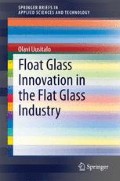Abstract
This chapter has five sections. In the first section, the empirical findings from the U.S. flat glass industry in 1920–1980 of the original study of cyclical model of technological change are revealed and discussed. In the original study used four-digit SIC codes for the definition of the industry. The focus in this research is to find out the impacts of this definition on the depth of the analysis. The second, third and fourth sections redefine the performance parameter, technological discontinuity and dominant design concepts of the cyclical model of technology, respectively. In the fifth section the flat glass industry is tested by means of a modified version of the cyclical model of technological change. For the test the U.S. plate glass and sheet glass industries are defined with more accurate five-digit SIC codes. Contrary to the original study of the cyclical model of technological change float glass emerged as the dominant design in both the plate glass industry and plate glass industry both in the United States and Europe. Finally there are critical comments on the entirely quantitative research method and the use of four digit SIC codes. These misinterpretations of the industry are discussed at the beginning of the chapter.
Access this chapter
Tax calculation will be finalised at checkout
Purchases are for personal use only
References
Ames BC (1974) Automation: key to greater productivity in glassmaking. Am Glass Rev February:11–12
Anderson P (1988) On the nature of technological progress and industrial dynamics. Unpublished PhD dissertation, Columbia University
Anderson P, Tushman LM (1990) Technological discontinuities and dominant designs: a cyclical model of technological change. Adm Sci Q 35:604–633
Anderson P, Tushman LM (1991) Managing through cycles of technological change. Res Technol Manage 34:26–31
Arrow K (1962) The economic implications of learning by doing. Rev Econ Stud 29:155–173
Barker TC (1994) An age of glass. Pilkington: the illustrated history. Boxtree, London
Daviet J-P (1989) Unemultinational a la Française. Histoire de Saint-Gobain 1665–1989. Fayard, Paris
Derclaye M (1982) La diffusion d’une innovation technique, le “float-glass” et ses consequences sur le marche du verre plat. Annales de Sciences Economiques Appliquees 38(1):133–148
Edge KC (1984) Section 11, flat glass manufacturing processes (update). In: Tooley F (ed) Handbook of glass manufacture, 3rd edn., vols I and II, Books for the glass industry division. Ashlee Publishing Co, New York, pp 714/1–21
Ford Motor Co. (1967) Newest Float Glass Plant. The Glass Industry, June, pp 309–313
Foster R (1986) Innovation: the attacker’s advantage. Summit Books, New York
Katz D, Kahn R (1966) The social psychology of organizations. Wiley, New York
Kinkead G (1983) The End of ease at Pilkington’s. Fortune, 21 March, pp 90–92, 94, 96
Miller D, Friesen PH (1982) The longitudinal analysis of organizations: a methodological perspective. Manage Sci 28(9):1013–1034
Mowery DC, Rosenberg N (1982) Technical change in the commercial aircraft industry, 1925–1975. In: Rosenberg N (ed) Inside the black box: technology and economics. Cambridge University Press, Cambridge, pp 163–177
Mowrey FW (1967) Technological progress in the flat glass industry. The Glass Industry, May, pp 247–249
Perry RC (1984) Float glass process: a new method or an extension of previous ones? The Glass Industry, February, pp 17–19, 31
Pilkington A (1963) The development of float glass. The Glass Industry, February, pp 80–81, 100–102
Pilkington A (1969b) Glass and windows chance memorial lecture. Chemistry and Industry, 8 February, pp 156–162
Quinn JB (1969) Technology transfer by multinational companies. Harvard Bus Rev 47(6):147–161
Quinn JB (1977) Pilkington Brothers LTD. The Amos Tuck School of Business Administration, Dartmouth College
Quinn JB (1980) Strategies for change. Logical incrementalism. Dow-Jones Irwin, Homewood
Quinn JB (1989) Pilkington Brothers P.L.C. In: Mintzberg H, Quinn JB (eds) The strategy process, concepts, contexts, cases. Prentice Hall, New Jersey
Rosenberg N (1982) Inside the black box: technology and economics. Cambridge University Press, Cambridge
Saint-Gobain (1965) Compagnie de Saint-Gobain, 1665–1965: Livre du tricentenaire, Paris
Skriba DA (1971) How a computer and glass communicate. The Glass Industry, December, pp 442–445
Spoerer M, Busi A, Krewinkel HW (1987) 500 Jahre Flachglas, 1487–1987 Von der Waldhütte zum Konzern, (in German, 500 year old flachglas, 1487–1987, from a small business to a concern). Karl Hofmann Verlag, Schorndorf
Tushman LM, Anderson P (1986) Technological discontinuities and organizational environments. Adm Sci Q 31:439–465
Tushman LM, Romanelli E (1985) Organizational evolution: a metamorphosis model of convergence and reorientation. Res Org Behav 7:171–222
Author information
Authors and Affiliations
Corresponding author
Rights and permissions
Copyright information
© 2014 The Author(s)
About this chapter
Cite this chapter
Uusitalo, O. (2014). Findings in Anderson’s (1988) Study. In: Float Glass Innovation in the Flat Glass Industry. SpringerBriefs in Applied Sciences and Technology. Springer, Cham. https://doi.org/10.1007/978-3-319-06829-9_5
Download citation
DOI: https://doi.org/10.1007/978-3-319-06829-9_5
Published:
Publisher Name: Springer, Cham
Print ISBN: 978-3-319-06828-2
Online ISBN: 978-3-319-06829-9
eBook Packages: EngineeringEngineering (R0)

